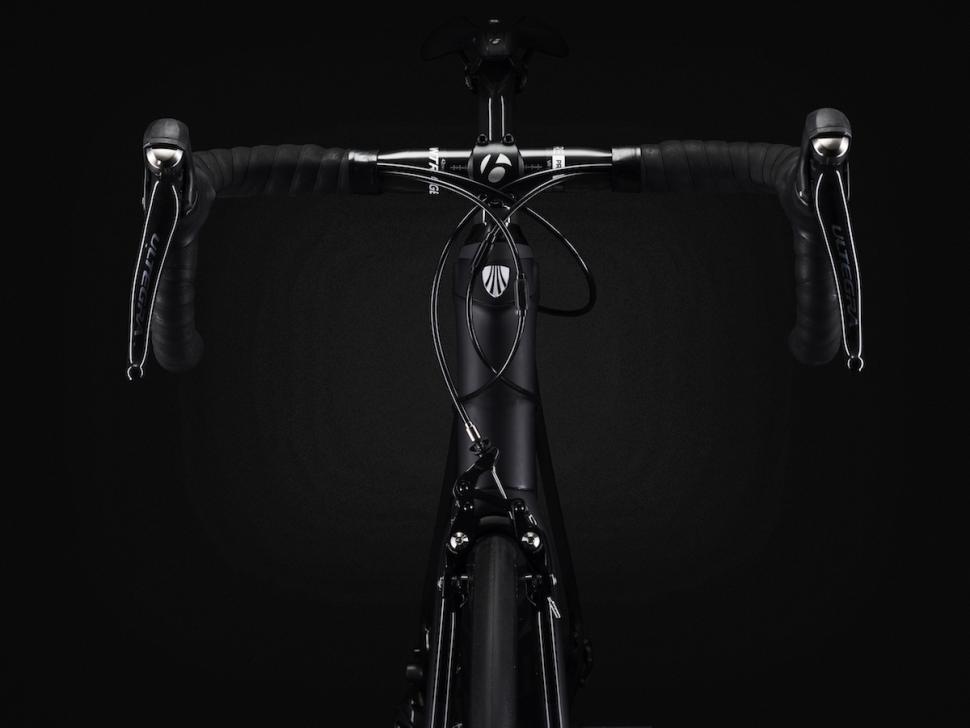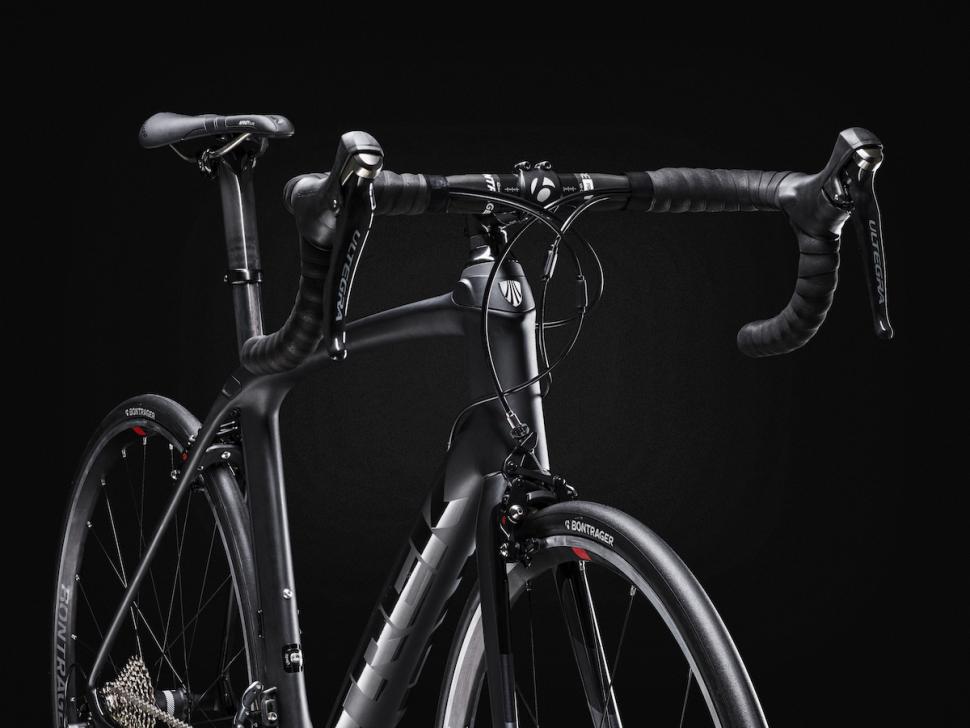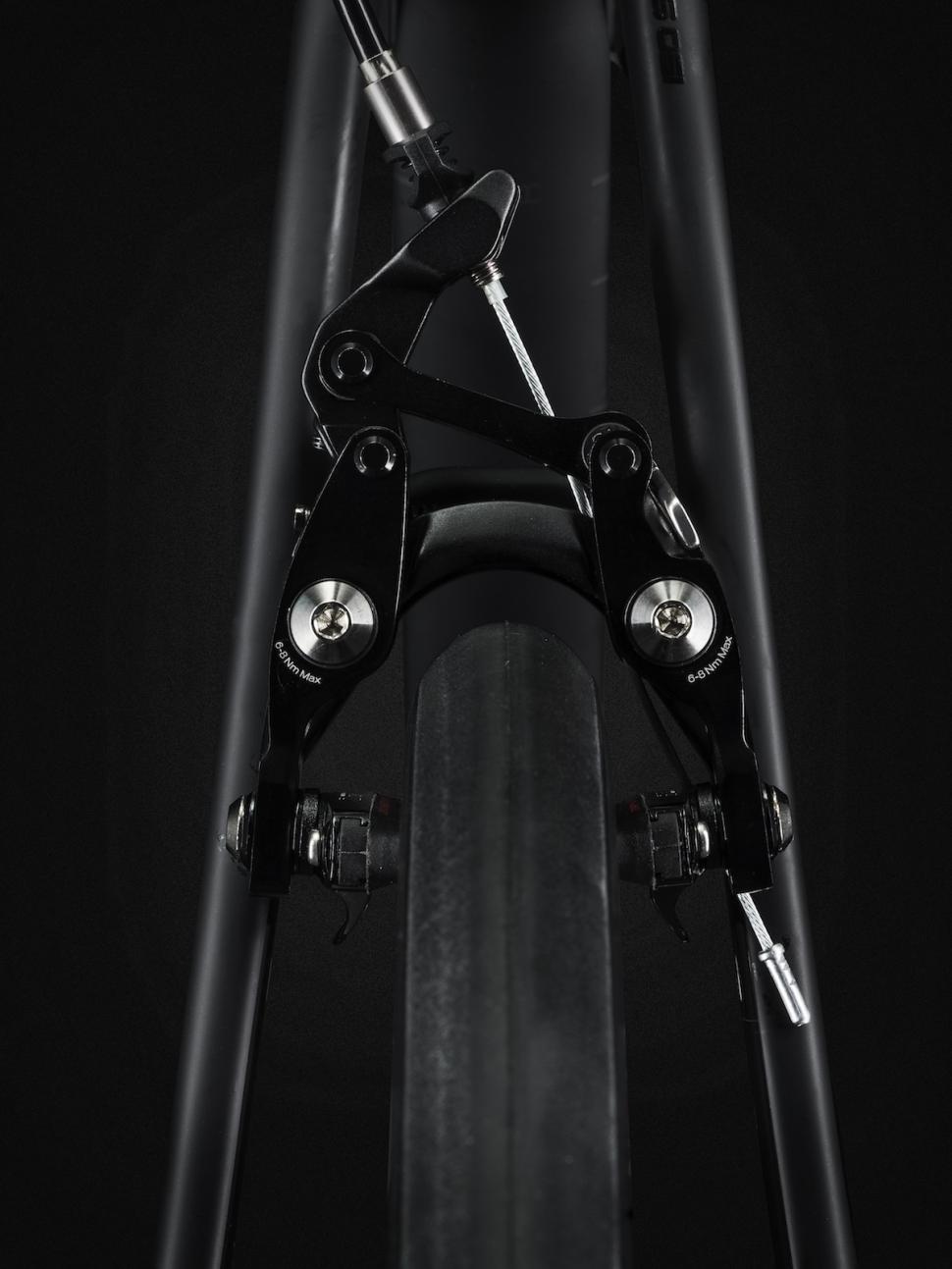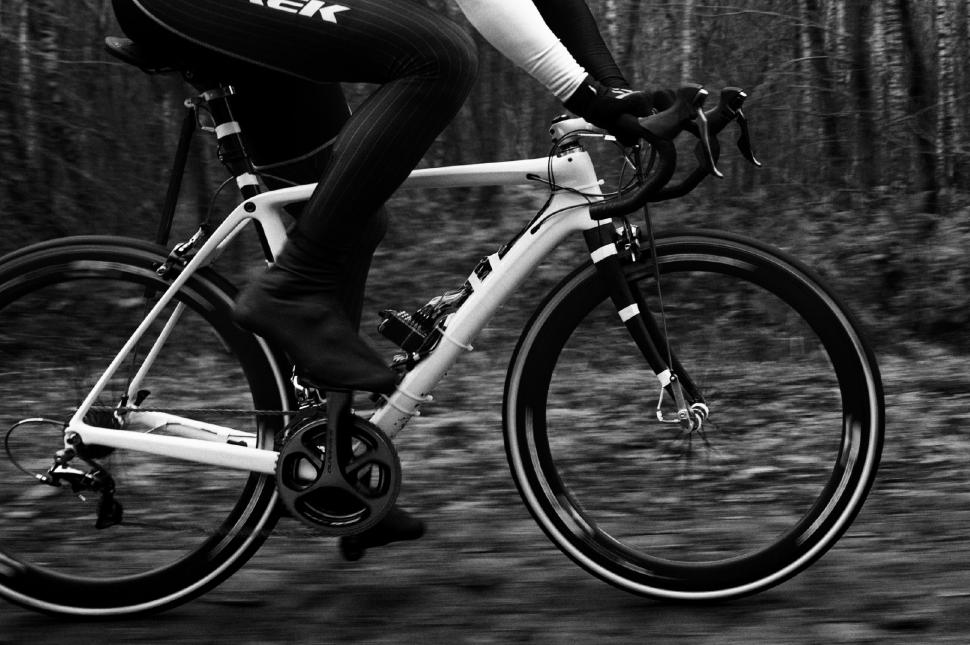- News
- Reviews
- Bikes
- Components
- Bar tape & grips
- Bottom brackets
- Brake & gear cables
- Brake & STI levers
- Brake pads & spares
- Brakes
- Cassettes & freewheels
- Chains
- Chainsets & chainrings
- Derailleurs - front
- Derailleurs - rear
- Forks
- Gear levers & shifters
- Groupsets
- Handlebars & extensions
- Headsets
- Hubs
- Inner tubes
- Pedals
- Quick releases & skewers
- Saddles
- Seatposts
- Stems
- Wheels
- Tyres
- Tubeless valves
- Accessories
- Accessories - misc
- Computer mounts
- Bags
- Bar ends
- Bike bags & cases
- Bottle cages
- Bottles
- Cameras
- Car racks
- Child seats
- Computers
- Glasses
- GPS units
- Helmets
- Lights - front
- Lights - rear
- Lights - sets
- Locks
- Mirrors
- Mudguards
- Racks
- Pumps & CO2 inflators
- Puncture kits
- Reflectives
- Smart watches
- Stands and racks
- Trailers
- Clothing
- Health, fitness and nutrition
- Tools and workshop
- Miscellaneous
- Buyers Guides
- Features
- Forum
- Recommends
- Podcast
TECH NEWS
New Trek Domane SLR launched with front and rear IsoSpeed decouplers
Trek has launched a new Domane that aims to build on the success of the first model, launched four years ago, with an adjustable IsoSpeed decoupler at the rear and an IsoSpeed decoupler at the front, plus a new IsoCore handlebar, all aimed at producing a bike that isolates the rider from rough roads and cobbles more than the previous Domane.
We spotted the new Domane at the Tour of Flanders over the weekend. We're now at the worldwide launch, where Fabian Cancellara himself was on hand to reveal the new bike. We're riding this new bike tomorrow so we'll be able to give you an indication of how it performs.
Here are the key developments and changes:
- Adjustable rear IsoSpeed
- Front IsoSpeed - so now the front of the bike moves with the terrain too
- IsoCore handlebar
- New fork
- Increased tyre clearance
- 12mm thru-axle on the disc bike
- Di2 function box port
Adjustable rear IsoSpeed
The new Domane provides a wider range of compliance - the amount it moves when it encounters a bump in the road, ranging from the stiffness of the Madone, to 14% more compliance than the previous Domane.
It can be easily adjusted. Jjust a single bolt needs to be loosened to adjust the slider in the seat tube. It’s not a change you can make on-the-fly. The bolt is neatly integrated into the lower bottle cage mount.
This sliding lever changes the level of compliance, from the lowest position which is claimed to offer 14% more compliance than the current Domane, to the top setting, which makes it as stiff as the Emonda.
The bike features a pair of seat tubes, connected via the IsoSpeed decoupler with a lower bolted joint. The slider adjusts the space between the two halves of the twin seat tube, allowing the seat mast to deflect rearwards.
“The slider contacts both the lower seat mast tube and main frame tube to limit the fore deflection of the lower seat mast per the user’s preference,” says Trek.
“If the slider is towards the bottom (near the bottom bracket), a user will experience greater compliance because of the greater vacant space that allows the lower seat mast to deflect more. If the slider is near the top (towards the IsoSpeed decoupler), a user will experience less compliance because the slider is inhibiting deflection in the vacant space below it.
“In the test lab, vertical stiffness testing at the saddle shows that for a 56cm frame, the compliance ranges from approximately 99N/mm to 144N/mm throughout the slider’s adjustment range.”
Front IsoSpeed
While the evolution of the rear IsoSpeed is impressive enough, more interesting is the development of the front IsoSpeed. It works very much like the rear IsoSpeed and addresses my biggest complaint of the previous Domane - that the front end is much stiffer than the back.
Trek describes the front IsoSpeed as a decoupler that allows the steerer tube to move back and forth, which results in a claimed 10% increase in vertical compliance. Stem length is a factor in the amount of deflection.
It’s essentially a pivoting collar that allows the top of the head tube and allows the steerer tube to move back and forth by a very small amount. This collar is bolted into the top of the steerer tube on both sides using elliptical nuts, and is free to rotate a small amount.
Slotting into this collar is a preload spacer, with an IsoSpeed head tube cover sitting on top. With these parts in place, the headset bearings are added, the compression spring, headset top cap and finally the stem.
This rotation allows the top of the steerer tube move back and forth, providing the deflection that should help smooth out impacts with cobbles.
We'll have more details on the exact workings of this front IsoSpeed decoupler soon.
IsoCore handlebar
Trek has also developed a new IsoCore handlebar that contributes to the front-end compliance. It’s based on the IsoZone handlebar but has a “ thermoplastic elastomer” integrated into the carbon fibre layup, throughout the entire handlebar, that is intended to dissipate vibrations by a claimed 20%. It does this anywhere on the handlebar, whether you’re riding on the drops or in the hoods.
Direct mount brakes, disc brakes and new fork
The new Domane is available in rim and disc brake versions. The rim brake version moves to direct mount brake calipers, and Trek has developed a new fork for the rim brake bike that is claimed to increase compliance by 7%.
For the disc bike, the company is using a fork with a 12mm thru-axle, which is increasingly looking like becoming the disc brake standard. Trek is also using the flat mount standard, as most new disc brake bikes are these days.
Extra tyre clearance
Trek recognises that more people are mixing up the surfaces they’re riding. Gravel and adventure bikes are hugely popular at the moment. The direct mount brakes on the rim brake version allow 28mm tyres to be fitted, while the disc version will take 32mm tyres with mudguards fitted. It’s a road race bike that is adaptable enough to be ridden on gravel roads or rough tracks, reckons Trek.
It certainly makes it appealing to British cyclists seeking a road bike with increased tyre clearance. And with the hidden mudguard mounts carried over from the previous Domane, it's ready for winter riding.
Control Centre
A port in the down tub, in other words. It’s something that first featured on the Madone, and is simply a port that the Di2 junction box is concealed within. It’s located under the bottle cage on the down tube. It’s a nice idea and removes the junction box strapped to the stem situation.
Pro Endurance Geometry
This is H1 fit but with endurance geometry, meaning a longer wheelbase, lower bottom bracket and shorter head tube, which is the same as the Madone and Emonda H1 fit.
Testing, testing...
Fabian Cancellara was instrumental in the development of the first Domane, and he was again with the new model. He rode the first prototype and did extensive testing, including riding a bike rigged up with measurement sensors, over the cobbles of Paris-Roubaix.
Furthermore, Trek constructed a 100 metre cobbled test track at its headquarters so it could run simulations through the development period of the bike, saving on long haul flights from the US.
Domano SLR prices
There will be five models of Domane SLR, two with disc brakes, and two framesets.
- Domane SLR 6 - £3,600
- Domane SLR 6 Disc - £4,000
- Domane SLR 7 - £4,400
- Domane SLR 7 Disc - £4,800
- Domane SLR 9 eTap - £7,600
- Domane SLR Disc Frameset - £2,550
- Domane SLR Frameset - £2,400
More details on the new Domane soon...
David worked on the road.cc tech team from 2012-2020. Previously he was editor of Bikemagic.com and before that staff writer at RCUK. He's a seasoned cyclist of all disciplines, from road to mountain biking, touring to cyclo-cross, he only wishes he had time to ride them all. He's mildly competitive, though he'll never admit it, and is a frequent road racer but is too lazy to do really well. He currently resides in the Cotswolds, and you can now find him over on his own YouTube channel David Arthur - Just Ride Bikes.
Latest Comments
- Surreyrider 1 sec ago
If I had to pick an annual race (bar Covid) I'd go for Paris-Roubaix....
- lesterama 26 min 35 sec ago
Great question! They are for MTB. Not sure for road.
- Cycle Happy 27 min 37 sec ago
Remaining articulate, intelligent and calm throughout like that whilst somebody is intentionally being threatening and abusive to not just yourself...
- hawkinspeter 1 hour 13 min ago
I kind of agree with that too, though the cost is probably not even a blip compared to their other costs. What would be interesting is comparing...
- hawkinspeter 1 hour 17 min ago
I share that hope too. I think it's slightly more complicated as the lower courts ordered that he had to be returned and now the Supreme Court have...
- Hirsute 2 hours 18 min ago
Although since September:...
- hawkinspeter 4 hours 47 min ago
I've got a pair of these shoes in the wide fitting and they're very comfortable. I also bought the Vaypor inner soles to go with them which come...
- SecretSam 5 hours 14 min ago
I think it's also worth noting that shoe fits change between shoes within the same brand's range - for example, my bike fitter told me that my...
- Secret_squirrel 5 hours 44 min ago
Seems a bit of a missed opportunity with such a deep unit not to include a little side window for better coverage....
- Paul J 5 hours 52 min ago
No video of the pro-am bike race? Shame.






































Add new comment
20 comments
Didn't seem to do Spartacus much good on the day.
Looks like a Boone frame with a Domane fork
The Boone seems to still be using the old IsoSpeed frame developed from the original Domane. Wonder if it'll inherit it in future - might want to make the pinch bolt less proud if so (bottle cage isn't going to be there much of the time) and seems to have a few extra spaces for mud to hide...
Very handsome. Great idea. Looks great. Really love it. However, I'll build something for 1/2 the price that is potentially as good.
Thanks for the replies. Travel or deflection, it's good to see some numbers.
BTW I'm not against suspension on road bikes, quite the opposite I believe that it makes a bike roll faster. I'm simply ultra sensitive to any marketing bs that manufacturers flood us with especially that so far "endurance" frames, "comfortable" seat post offered almost no measurable deflection that would make any noticeable difference comparing to the benefits of wider tyres run at sensible pressure.
As for tyre travel, 20mm is quite conservative. My 25mm and 28mm (27mm and 31mm actual widths) tyres run tubeless at 65-70PSI offer more than that... On typical UK roads the bike just glides over rough stuff.
Agree that there's a lot of marketing bollocks about in general, although Trek are better than most with a pretty strong engineering bent - probably not hindered by a long association with Keith Bontrager As far as compliance is concerned, you might be surprised how much flex you can get from some frames and seat posts and the IsoSpeed set-up gives an easily visible amount even using your hands.. the Canyon VCLS seat-post is supposed to be pretty noticeable as well. Again, this is in addition to tyre or other effects - as a 'for instance' I used to be able to pedal through some sharp level transitions on one regular route better on my old Domane 2.0 with Hutchinson Fusion 3 23mm tubeless @ 90F/95R psi than my Wilier Izoard XP on 25mm Vittoria Open Pave at 80F/85R psi - almost purely because the comparative lack of jolting (there's no much difference at the front end, slightly better on the Paves at removing buzz).
As far as compliance is concerned, you might be surprised how much flex you can get from some frames and seat posts and the IsoSpeed set-up gives an easily visible amount even using your hands.. the Canyon VCLS seat-post is supposed to be pretty noticeable as well. Again, this is in addition to tyre or other effects - as a 'for instance' I used to be able to pedal through some sharp level transitions on one regular route better on my old Domane 2.0 with Hutchinson Fusion 3 23mm tubeless @ 90F/95R psi than my Wilier Izoard XP on 25mm Vittoria Open Pave at 80F/85R psi - almost purely because the comparative lack of jolting (there's no much difference at the front end, slightly better on the Paves at removing buzz).
That's why I said 'racey road clincher tyres' and 'risk of pinch flats' and also mentioned the predominant widths It's not conservative for those folk who are a lot more numerous than those running wide tubeless and again, it's not either/or just an increase in comfort. Matter of interest, what 28s are you using ? I'm thinking of some 28mm Schwalbe One next (or Pro One if I can get my hands on them at a decent price) but open to persuasion on others.
It's not conservative for those folk who are a lot more numerous than those running wide tubeless and again, it's not either/or just an increase in comfort. Matter of interest, what 28s are you using ? I'm thinking of some 28mm Schwalbe One next (or Pro One if I can get my hands on them at a decent price) but open to persuasion on others.
Schwalbe One. They are lovely.
Tah, think they stay pretty much at the top of the list then..
I'm not a techohead, but what I do know is that my Domane 2.0 (which I use for commuting and winter riding) is easily the most comfortable bike I've ever had. It's certainly more comfortable than my carbon Specialized Roubaix. Having an Iso-coupler on the front and not just rear sounds an excellent idea.
Never mind the technical details/rubbish, what about the COLOUR(s)?!?!
it's really just a flex stem given a bit of a tart up
I thought that too to begin with, not so sure now i've seen some more pictures - looks like it might be more similar to the old IsoSpeed setup at the rear (steerer tube inside the pivoting cage, flexing from the bottom of the head tube/bearing cup).
How does the meaningless "14%" of extra "compliance" claim translate to actual (suspension) travel?
Are we talking about 1mm? 10mm?...
Indeed. 14% of what exactly?
I do feel for the manufacturers though, I suspect the industry understands that like for like comparisons aren't good for anybody long term. As soon someone's bike has 1.5mm deflection @ 50N then the next company needs to bring out 1.6mm @ 50Nm next month... it may not mean a better ride at all but people just buy off spec. The motorbike industry struggled similarly with the whole horsepower/kg metric...
It's in the article, e.g.
To their credit they do seem reasonably consistent in their language, which itself seems sensible IMO considering the engineering meaning of 'compliance'.
Still completely meaningless as it says nothing about the travel.
The old Madone had about 23mm maximum vertical deflection on the rear frame, and the old Domane had around 35mm - although as David mentioned this is dependent on rider weight amongst other things.
These things aren't exclusive either, buying this bike won't suddenly stop you getting the benefit from the tyres, so don't see the issue - with this you get more, if you don't need or want it, put your money elsewhere. Or don't buy it, it's not compulsory. The amount of racey road clincher tyres that will offer you "at least 20mm" vertical deflection without running the risk of pinch flats is increasing, which is good, but 23mm is still plentiful and 25mm only now becoming 'normal'.
If you've spent any time on an ISOspeed bike you'll know that the bottom line is old ISOspeed worked really well, this sounds like an improvement on that (and with a bit more give at the front) and this is on top of everything you get from tyres, bar tape, gel and/or whathaveyou. If you've not, why not give it a try and see why people seem to like it.
The IsoSpeed isn't suspension. It doesn't have travel. To put it simply, the seatpost bends backwards when you hit a bump or hole in the road with enough force. I've just been chatting to Trek and they tell me the previous Domane had a maximum deflection range of about 35mm, but this depends on lots of factors like rider weight etc. I'll have more from the launch soon...
ie used a prepreg with a resin that's rubber toughned.